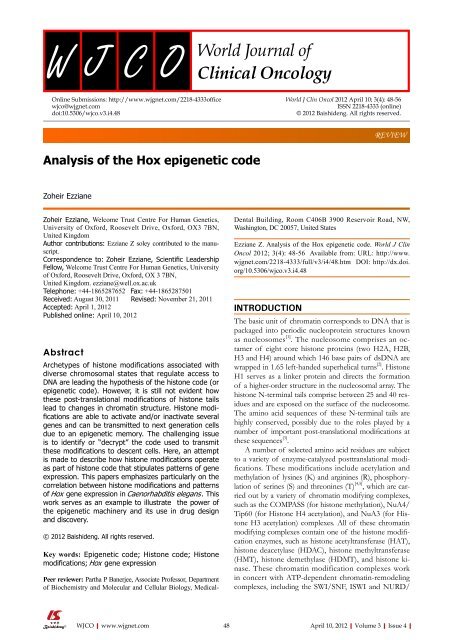World Journal of Clinical Oncology
World Journal of Clinical Oncology
World Journal of Clinical Oncology
Create successful ePaper yourself
Turn your PDF publications into a flip-book with our unique Google optimized e-Paper software.
W J C O<br />
Online Submissions: http://www.wjgnet.com/2218-4333<strong>of</strong>fice<br />
wjco@wjgnet.com<br />
doi:10.5306/wjco.v3.i4.48<br />
Analysis <strong>of</strong> the Hox epigenetic code<br />
Zoheir Ezziane<br />
Zoheir Ezziane, Welcome Trust Centre For Human Genetics,<br />
University <strong>of</strong> Oxford, Roosevelt Drive, Oxford, OX3 7BN,<br />
United Kingdom<br />
Author contributions: Ezziane Z soley contributed to the manuscript.<br />
Correspondence to: Zoheir Ezziane, Scientific Leadership<br />
Fellow, Welcome Trust Centre For Human Genetics, University<br />
<strong>of</strong> Oxford, Roosevelt Drive, Oxford, OX 3 7BN,<br />
United Kingdom. ezziane@well.ox.ac.uk<br />
Telephone: +44-1865287652 Fax: +44-1865287501<br />
Received: August 30, 2011 Revised: November 21, 2011<br />
Accepted: April 1, 2012<br />
Published online: April 10, 2012<br />
Abstract<br />
Archetypes <strong>of</strong> histone modifications associated with<br />
diverse chromosomal states that regulate access to<br />
DNA are leading the hypothesis <strong>of</strong> the histone code (or<br />
epigenetic code). However, it is still not evident how<br />
these post-translational modifications <strong>of</strong> histone tails<br />
lead to changes in chromatin structure. Histone modifications<br />
are able to activate and/or inactivate several<br />
genes and can be transmitted to next generation cells<br />
due to an epigenetic memory. The challenging issue<br />
is to identify or “decrypt” the code used to transmit<br />
these modifications to descent cells. Here, an attempt<br />
is made to describe how histone modifications operate<br />
as part <strong>of</strong> histone code that stipulates patterns <strong>of</strong> gene<br />
expression. This papers emphasizes particularly on the<br />
correlation between histone modifications and patterns<br />
<strong>of</strong> Hox gene expression in Caenorhabditis elegans . This<br />
work serves as an example to illustrate the power <strong>of</strong><br />
the epigenetic machinery and its use in drug design<br />
and discovery.<br />
© 2012 Baishideng. All rights reserved.<br />
Key words: Epigenetic code; Histone code; Histone<br />
modifications; Hox gene expression<br />
Peer reviewer: Partha P Banerjee, Associate Pr<strong>of</strong>essor, Department<br />
<strong>of</strong> Biochemistry and Molecular and Cellular Biology, Medical-<br />
WJCO|www.wjgnet.com<br />
<strong>World</strong> <strong>Journal</strong> <strong>of</strong><br />
<strong>Clinical</strong> <strong>Oncology</strong><br />
REVIEW<br />
Dental Building, Room C406B 3900 Reservoir Road, NW,<br />
Washington, DC 20057, United States<br />
Ezziane Z. Analysis <strong>of</strong> the Hox epigenetic code. <strong>World</strong> J Clin<br />
Oncol 2012; 3(4): 48-56 Available from: URL: http://www.<br />
wjgnet.com/2218-4333/full/v3/i4/48.htm DOI: http://dx.doi.<br />
org/10.5306/wjco.v3.i4.48<br />
INTRODUCTION<br />
<strong>World</strong> J Clin Oncol 2012 April 10; 3(4): 48-56<br />
ISSN 2218-4333 (online)<br />
© 2012 Baishideng. All rights reserved.<br />
The basic unit <strong>of</strong> chromatin corresponds to DNA that is<br />
packaged into periodic nucleoprotein structures known<br />
as nucleosomes [1] . The nucleosome comprises an octamer<br />
<strong>of</strong> eight core histone proteins (two H2A, H2B,<br />
H3 and H4) around which 146 base pairs <strong>of</strong> dsDNA are<br />
wrapped in 1.65 left-handed superhelical turns [2] . Histone<br />
H1 serves as a linker protein and directs the formation<br />
<strong>of</strong> a higher-order structure in the nucleosomal array. The<br />
histone N-terminal tails comprise between 25 and 40 residues<br />
and are exposed on the surface <strong>of</strong> the nucleosome.<br />
The amino acid sequences <strong>of</strong> these N-terminal tails are<br />
highly conserved, possibly due to the roles played by a<br />
number <strong>of</strong> important post-translational modifications at<br />
these sequences [3] .<br />
A number <strong>of</strong> selected amino acid residues are subject<br />
to a variety <strong>of</strong> enzyme-catalyzed posttranslational modifications.<br />
These modifications include acetylation and<br />
methylation <strong>of</strong> lysines (K) and arginines (R), phosphorylation<br />
<strong>of</strong> serines (S) and threonines (T) [4,5] , which are carried<br />
out by a variety <strong>of</strong> chromatin modifying complexes,<br />
such as the COMPASS (for histone methylation), NuA4/<br />
Tip60 (for Histone H4 acetylation), and NuA3 (for Histone<br />
H3 acetylation) complexes. All <strong>of</strong> these chromatin<br />
modifying complexes contain one <strong>of</strong> the histone modification<br />
enzymes, such as histone acetyltransferase (HAT),<br />
histone deacetylase (HDAC), histone methyltransferase<br />
(HMT), histone demethylase (HDMT), and histone kinase.<br />
These chromatin modification complexes work<br />
in concert with ATP-dependent chromatin-remodeling<br />
complexes, including the SWI/SNF, ISWI and NURD/<br />
48 April 10, 2012|Volume 3|Issue 4|

















